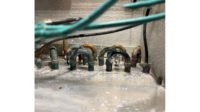Most refrigerant leaks are not very difficult to locate, but occasionally, you do come across a system where the location of the leak is very difficult to find or verify. These jobs can be quite problematic and costly to resolve.
When you are unable to find a leak, first make sure that you are not the reason. If you are using an electronic leak detector, is it working? It is good practice to always test your electronic leak detector before using it. I once had a technician working for me who spent three hours looking for a leak before he realized his electronic leak detector was not working. Also — and this might sound obvious because it is — make sure the system is pressurized with refrigerant or nitrogen when leak searching. Again, I had a different technician spend two hours looking for a leak before he realized there was no refrigerant in the system.
When trying to find those hard-to-locate leaks, patience is generally your best tool. You will find the leak, but it might take time. Using dyes can be a viable option, but the leak needs to be in a visible location, so it may not always be helpful.
When you really cannot find the leak, splitting the system into sections is a useful method. It is also a way of proving the leak location if you are not able to soap up the area and see it. However, it does require recovering the refrigerant and separating some of the system components, so it is not an easy or inexpensive solution. Usually, this is only done when you really cannot find the leak and it must be located.
There are many ways of splitting up a system, but one common method is to split it into three sections: pressurize the evaporator, line set, and condensing unit separately. This will show you which section is leaking, and you can then decide whether to continue leak searching that section or simply change out the section.
Many years ago, we were working on an air conditioning system with a remote, indoor, air-cooled condenser for a computer room. The system had a leak that we were unable to locate using traditional methods. The line set for the remote condenser was quite long and not easily accessed, and we assumed the leak must be there. I am a big believer in not replacing or repairing a leak without visually confirming it with soap bubbles.
We convinced the customer to allow us to shut down the unit, recover the refrigerant, and divide and pressurize the system into three sections: the condenser, line set, and indoor section. This allowed us to discover that the leak was actually in the condenser and on a Schrader core with a loose cap. We had a little egg on our face, because when we initially leak-searched the condenser, we did not turn off the blower for the condenser fan. This was a big mistake, as it did not allow us to accurately search the condenser.
We learned a big lesson that it is better to leak-search a system when it is totally off. Since it was a computer room, we thought it was best to leave the system running, but that was a bad call on our part. Fortunately, we did eventually locate the leak and repair it.







